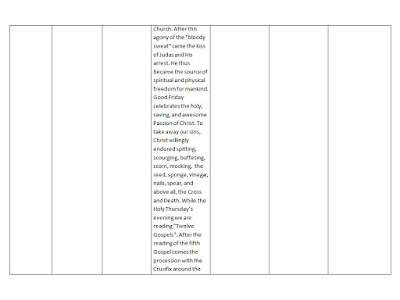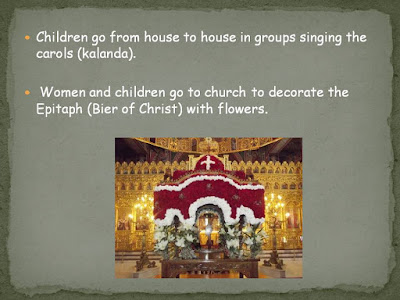School preparation for the workshop about doing surveys on native traditions, rites and customs concerning the major spring religious holiday in Greece: Easter.
We meet to decide on the type of presentation and rituals we are going to present to partner teams to Bulgaria.
Survey on common spring / Easter traditions
The Greek workshop
RELIGION:
Orthodox Christians
Easter Symbols:
·
Easter eggs
·
The Easter bunny
·
The Easter lilies
·
The lamb
·
The cross
·
Hot cross buns
·
Candles
·
Pretzels
·
The butterfly
BELIEFS:
•
Easter
also called Pasch or Resurrection Sunday is a festival and holiday celebrating
the Resurrection of Jesus Christ from the dead, described in the New Testament
as having occurred three days after his crucifixion by Romans at Calvary. It is
the culmination of the Passion of Christ, preceded by Lent ,a forty-day period
of fasting, prayer, and penance.
ACTIVITIES:
•
Saturday Morning of St. Lazarus.
On this day, the rising from the dead of
St. Lazarus, the righteous friend of Christ, is celebrated . A short time
earlier Christ had risen Lazarus from the dead, thereby gaining the respect and
faith of the people, but also the hatred of the fanatics. The Church names this
day the “Saturday of Lazarus” in remembrance of the resurrection of Lazarus and
its promise of universal resurrection for all men.
•
• Sunday Morning.
Palm Sunday celebrates the glorious and
brilliant feast of the Entrance of Jesus into Jerusalem. The main road leading
to Jerusalem was covered with palm trees. The multitudes, with palm branches in
their hands, spread their cloaks on the road as a show of respect, crying out,
"Hosanna to the Son of David, blessed is He that comes in the name of the
Lord.'
•
Great Holy and Monday Morning.
Holy Monday or Great and Holy Monday is
the Monday of Holy Week, which precedes the commemoration of the Death and
Resurrection of Jesus.
• Great Holy Tuesday Evening.
On Wednesday of Holy Week ,it has been
ordained by the Holy Fathers of the Church that commemoration should be made of
the anointing of Christ with myrrh by the woman in the house of Simon.
Repentance was the mission of the prophets. It would be an apt one-word title
for the Bible, because "repentance" was the mission of our Lord. On
this evening is sung the beautiful "Hymn of Cassiane," probably a
work of Patriarch Photius.
•
Great Holy and Wednesday Evening.
It is the evening of repentance,
confession, and the remission of sins by the Lord, preparing the faithful to
receive Holy Communion, usually the next day, Holy Thursday morning. Holy
Unction is the Mystery for cleansing sins and renewing the body and the spirit
of the faithful.
•
Great Holy Thursday Morning and Evening.
Jesus drew His last breath of freedom on
this Thursday night. Christ knew all the incidents which were about to take
place and called to Him His Apostles in order to institute the Holy Eucharist
for them and for the Church forever. Christ presented Bread and Wine as the
Elements of His Very Body and His Very Blood; they are the Precious Gifts which
have been left as His perpetual Presence in the Church. After this agony of the
"bloody sweat" came the kiss of Judas and His arrest. He thus became the
source of spiritual and physical freedom for mankind. Good Friday celebrates
the holy, saving, and awesome Passion of Christ. To take away our sins, Christ
willingly endured spitting, scourging, buffeting, scorn, mocking, the reed, sponge, vinegar, nails, spear, and
above all, the Cross and Death. While the Holy Thursday’s evening we are
reading "Twelve Gospels". After the reading of the fifth Gospel comes
the procession with the Crucifix around the church, while the priest chants the
15th antiphon. On Holy Thursday we also
dying eggs, baking cookies and we never listen to music.
•
Holy Friday Morning and Evening.
As the priest reads the Gospel, "and
taking the body, Joseph wrapped it in a white cloth," he removes the Body
of Christ from the Cross, wraps It in a white cloth, and takes It to the altar.
The priest then chants a mourning hymn. Then he carries the cloth on which the
Body of Christ is painted or embroidered around the church before placing It
inside the Sepulcher, a carved bier which symbolizes the Tomb of Christ. We are
reminded that during Christ's entombment, He descends into Hades to free the
dead of the ages before His Incarnation. Christians observe Good Friday with
fasting, prayer, cleanliness, self-examination, confession, and good works, in
humility and repentance so that the Grace of the Cross might descend upon them.
• Great Holy Saturday Morning.
Psalms are read and Resurrection hymns are
sung which tell of Christ's descent into Hades. Thus this day's celebration is
called "First Resurrection." After the reading of the Epistle, the
priest follows the custom of tossing of laurel. The Divine Liturgy ends with
the Communion Hymn: "So the Lord awaked as one out of sleep, and He is
risen to save us."At the evening we are going to the church and at twelve
o’clock we celebrate the resurrection of Jesus Christ. The Orthros of the
Resurrection begins in complete darkness. The priest takes light from the vigil
light and gives it to the faithful, who are holding candles. Then comes the
breathless moment as the people wait for the priest to start the hymn of
Resurrection, which they join him in singing, repeatedly: "Christ has
Risen from the dead, by death trampling upon Death, and has bestowed life upon
those in the tombs." From this moment, the entire service takes on a
joyous Easter atmosphere. Then we return to our homes where we are eating a
traditional meal. We are holding the holy fire at our candles for about 40
days.
•
The
Holy Sunday of Easter.
Easter Sunday afternoon, the faithful gather
once more for prayer with lighted candles. All sing the hymn, "Christ is
Risen from the Dead." The people greet one another joyously, saying:
"Christ is Risen," the Easter salutation which is answered,
"Truly He is Risen. On Sunday’s morning we celebrate the resurrection of
Jesus. We are together with all of our relatives and we roast lamps and dance
until the night.
FOODS AND
DRINKS:
Easter foods:
·
Tsoureki,
a sweet Easter bread, is another food prepared during the traditionally frugal
Holy Week.
·
A
special soup called magiritsa which is made with lamb innards.
·
Lamb
·
Red
eggs
·
Cookies
Easter drinks:
·
Wine
·
Ouzo
·
Tsipouro
CUSTOMS:
·
Each
person holds an egg and taps the eggs of others in the family. Whoever manages
to break the other eggs without breaking their own is the winner.Τhe game is called tsougrisma.
·
The
family chooses a lamb, they put it on a spit and cook it over coal for hours.
·
People
exchange wishes such as Christos Anesti and Alithos o Kirios.
·
Shortly
before midnight, people gather in church holding white candles which they light
with the “Holy Light” distributed by the priest.
·
With
the Holy Light of the candles, we make three times the sign of the cross on the
door post over the front door of their houses for good luck.
·
Children
go from house to house in groups singing the carols (kalanda).
·
Women
and children go to church to decorate the Epitaph (Bier of Christ) with
flowers.
·
On
Saturday morning, preparations start for the festive dinner and a special soup
is cooked called “maghiritsa”.
·
Because
Friday is a day of mourning, housewives avoid doing housework.
·
Housewives
traditionally prepare special cakes named tsourekia, biscuits and red color
eggs.




































No comments:
Post a Comment